May 31, 2020
Ester based type and Ether based type are the two basic types of Polyurethane tubing, they all have good chemical resistance and mechanical performance such as abrasion resistance and tear resistance.
Because of the different polyols used in the formulation, these two types of PU tubes exhibit different properties.
Ester based polyurethane tubing has excellent abrasion resistance and tensile resistance with lower cost. In contrast, Ether based polyurethane tubing has low water absorption, hydrolysis resistance, fungi resistance, low temperature resistance, and effectively Ultraviolet resistance.
The disadvantage of Ether based type is that its production cost is higher than regular Ester based type.
Performance Contrast of Ester based and Ether based Polyurethane Tubing: | |
| Tensile resistance | Ester-based > Ether-based |
| Tear resistance | Ester-based > Ether-based |
| Abrasion resistance | Ester-based > Ether-based |
| Chemical resistance | Ester-based > Ether-based |
| Transparency | Ester-based > Ether-based |
| Bacterial resistance | Ester-based < Ether-based |
| Moisture evaporation | Ester-based < Ether-based |
Low temperature impact toughness | Ester-based < Ether-based |
Ester based polyurethane refers to the polyurethane whose polyol mainly uses trimethylolpropane, neopentyl glycol, ethylene acetal, 1,3-butanediol, and the dibasic acids used are adipic acid, phthalic anhydride, meta- Phthalic acid, terephthalic acid, etc. Most of the common TPU tubing belongs to polyester polyurethane type.
◆ Can withstand higher temperatures
◆ Has excellent abrasion resistance and dielectric strength
◆ Better fuel resistance
◆ Good chemical resistance
◆ Lower cost
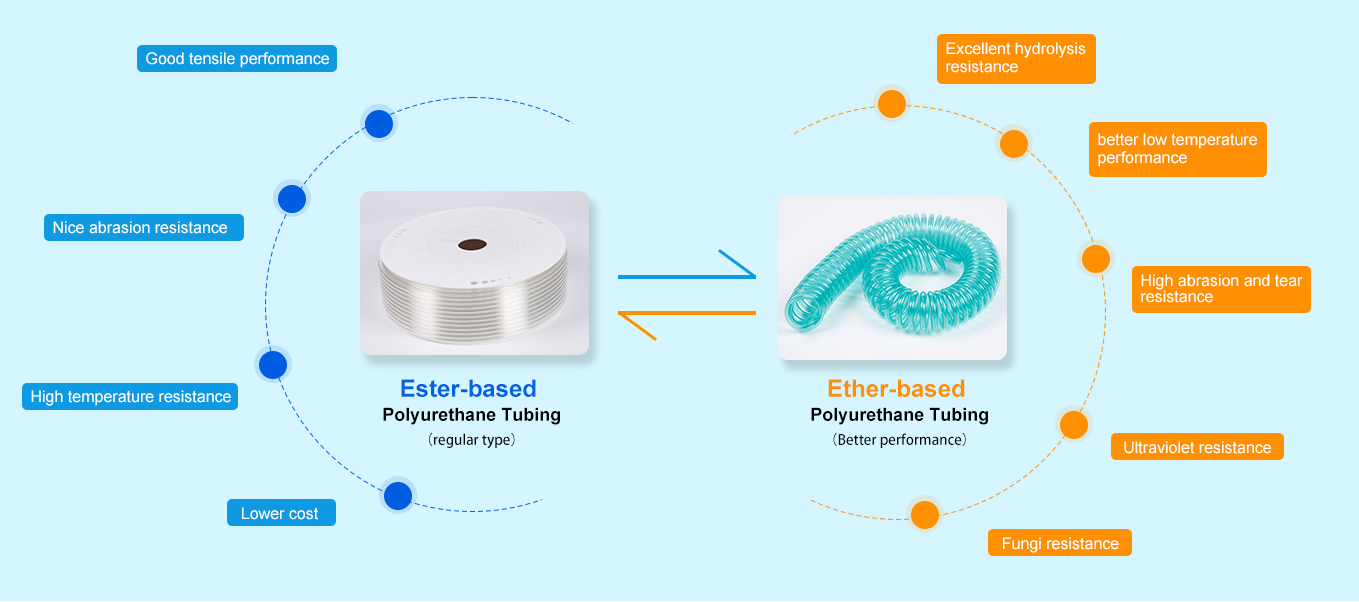
Polyether based polyurethane is mainly defined for the polyol used in the preparation of polyurethane materials, that is, the polyol used for the preparation of polyurethane is completely composed of polyether type polyols or occupies most of the system. Developed by the NASA company HEALHTMAN.
In the molecular structure of polyether polyol, the cohesive energy of the ether bond is low and it is easy to rotate, so the polyurethane material produced by it has good low temperature flexibility and excellent hydrolysis resistance.
Although the mechanical properties are not as good as polyester polyurethane, the viscosity of the raw material system is low. It is easily miscible with isocyanates, additives and other components, and has excellent processing performance.
◆ Low temperature resistance
◆ Antifungal
◆ Hydrolysis resistance, low water absorption, moisture resistance
◆ Does not generate heat
◆ UV resistant and thus more resistant to ageing
◆ Good shock absorption
◆ High resilience
◆ Higher cost

Common thermoplastic polyether ester elastomer is very widely used because of its good stability, chemical resistance, resilience and mechanical properties, heat insulation, sound insulation, shock resistance, and anti-virus properties.
Polyester polyurethane is often used as packaging, sound insulation and filter materials, as well as construction, automotive, thermal insulation industry, shoe industry. Ester based Polyurethane is often seen in the fields of household, daily necessities, transportation, and home appliances.
Because polyether polyurethane has antibacterial properties, hydrolysis resistance and good low temperature performance, it is a good temperature-sensitive decompression material.
The internal tissue is arranged in a spherical shape and has good air permeability. It is usually used in medical, food, aviation and other fields'material.
The main raw materials for the production and processing of polyether TPU are 4-4'-diphenylmethane gas diisocyanate (MDI), polytetrahydrofuran (PTMEG), 1,4-butanediol (BDO), among which the demand for MDI is about At about 40%, PTMEG accounts for about 40%, and BDO accounts for about 20%.
The main raw materials for polyester TPU production and processing are 4-4'-diphenylmethane gas diisocyanate (MDI), 1,4-butanediol (BDO), and adipic acid (AA).
Among them, the demand for MDI is About 40%, AA about 35%, and BDO about 25%.
Molecular mass distribution and influence.
The relative molecular mass distribution of polyether is narrow and follows the Poisson probability expression; while the relative molecular mass distribution of polyester diol is wider and follows the general Flory probability.
The soft segment is composed of oligomer polyols such as polyether and polyester. The soft segment accounts for most of the polyurethane, and the properties of the polyurethane obtained from different oligomer polyols and diisocyanates are different.
Polyurethane elastomer materials and foams obtained with strong polar polyester as soft segments have very good mechanical properties.
Because the polyurethane made of polyester contains a highly polar ester group, not only hydrogen bonds can be formed between the hard segments, but also the polar groups on the soft segment can partially interact with the polar groups on the hard segment.
The group forms hydrogen bonds, so that the hard phase can be more uniformly distributed in the soft phase, which acts as an elastic cross-linking point.
At room temperature, some polyesters can cause soft segment crystallization, which affects the performance of polyurethane.
The strength, oil resistance and thermal oxidation stability of polyester polyurethane are higher than those of PPG polyether type, but the hydrolysis resistance is worse than that of polyether type.
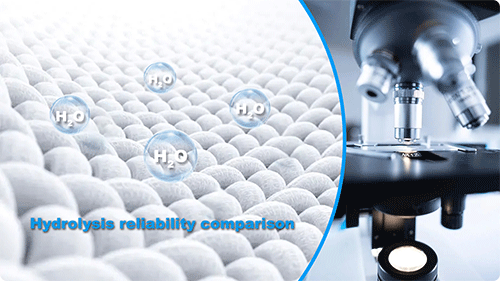
After the polyester polyurethane is maintained with carbodiimide, the hydrolysis resistance is significantly improved. Polyester polyurethane and polyether polyurethane have the best hydrolysis resistance in high temperature weather.
Polyesters are vulnerable to moisture content and cause breakage, and the acid generated by hydrolysis can catalyze further hydrolysis of polyesters.
The type of polyester has a certain influence on the physical properties and water resistance of the elastomer material.
With the increase of the number of methylene groups in the polyester diol raw material, the water resistance of the prepared polyester polyurethane elastomer material is improved. The content of ester group is smaller, and its water resistance is also better.
Similarly, using polyester synthesized from long-chain dibasic acid, the water resistance of the obtained polyurethane elastomer is better than that of short-chain dibasic acid polyester polyurethane.
Polyester soft thermoplastic polyurethane is in contact with moist soil for a long time and will be eroded by microorganisms, while polyether soft or hard thermoplastic polyurethane is usually not susceptible to microbial erosion.
Compared with polyester polyurethane elastomer materials, polyether polyurethane elastomer materials are much higher in cost. The main reasons are:
◆ Polyether polyurethane elastomer material has good hydrolysis resistance, ultra-low temperature resistance and bending resistance.
◆ Compared with polyester polyol, the polyether polyol that constitutes the soft segment of TPU has a higher price of raw materials for production and processing.
◆ The production process of polyether polyol is much more complicated than that of polyester polyol.
◆ The production process specification of polyether polyols in the process of chemical change is difficult to control.
◆ In the production and processing of polyether polyols, the demand for production equipment is high. In addition, certain protective measures must be selected during the production process.
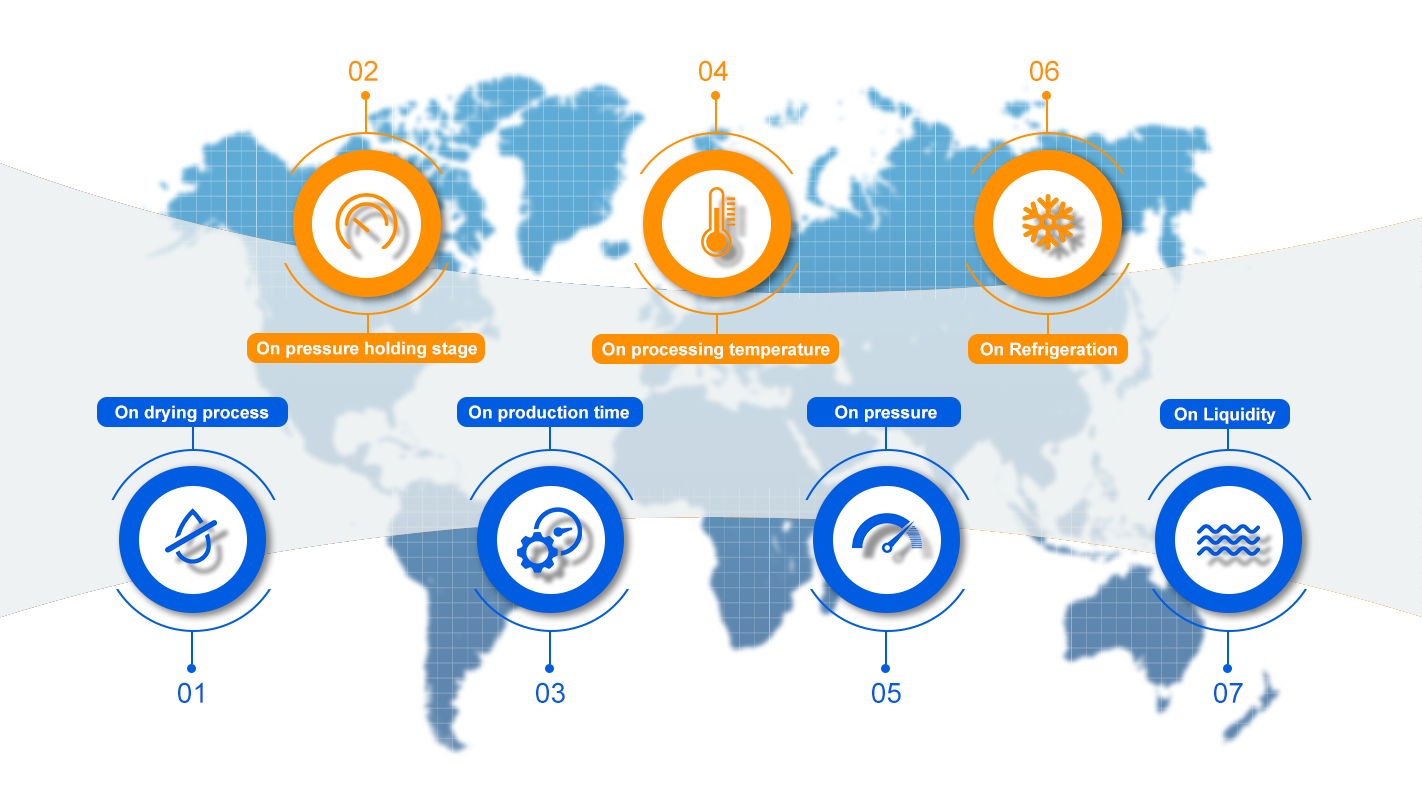
Difference comparison of production process between polyester and polyether TPU.
Polyurethanes, as we know them, are polar polymers that slowly absorb moisture when exposed to air.
The hygroscopic TPU pellets are melted and formed, and the water is vaporized under the high temperature during production, which makes the surface of the product not smooth, and bubbles are generated inside, thereby reducing the physical properties.
Therefore, in order to better ensure the performance of the equipment and prevent air bubbles caused by moisture vaporization during melting and manufacturing, it is generally necessary to dry the TPU pellets before TPU production.
Through the previous analysis, we know that polyester is vulnerable to moisture content and cause breakage
, and the acid produced by hydrolysis can catalyze further hydrolysis of polyester.
Under the same conditions, the water content of polyester polyurethane is higher than that of polyether polyurethane.
So in the drying process, it is much higher special attention should be paid to the thorough drying of polyester TPU, and the drying conditions should be strictly controlled than polyethers.
During the injection molding process of the polymer melt, whether it is the pre-molding stage or the injection molding stage, the melt must withstand the combined action of internal static pressure and external dynamic pressure.
In the holding pressure stage, the polymer melt will be subjected to high pressure.
Under this pressure, the free volume between the molecular segments will be compressed, and the proximity of the macromolecular segments will strengthen the intermolecular force, that is, the viscosity will increase.
In addition, due to the low cohesion energy of the ether bond of the polyether polyurethane, the rotational barrier of the bond is small, resulting in a small interaction between the tight segments of the reinforcing molecular chain, so the relative displacement of the molecular formula chain is large during compression, and thus the viscosity performance can vary within a large range.
Moreover, since the molecular chain of polyether polyurethane is much softer than that of polyester polyurethane, it is difficult to form permanent deformation.
Therefore, when holding pressure during the processing of polyether polyurethane, compared with polyester TPU, polyether TPU requires a longer holding time.
In general, the increase in molecular weight makes the molecular chain longer, the slower the center of gravity of the molecular chain moves, the more opportunities for the relative displacement between the segments to cancel.
The flexibility of the long molecular chain increases, the entanglement points increase, and the chain is difficult to disengage and slide. , the resistance of the flow process increases, and the time and energy required also increase, showing the sensitivity of viscosity to shear.
Under normal circumstances, polyester TPU has a larger molecular weight than polyether TPU, so it takes longer to produce and mold.
In general, polyester based polyurethane has a wider molecular mass distribution than polyether based polyurethane, so the temperature required in the production process is also higher.
Since the nitrogen-oxygen bond of polyether TPU is very easy to break, it can be processed and produced at a relatively low temperature.
Due to the high molecular cohesion energy of polyester TPU, the nitrogen-oxygen bond in its molecular structure is difficult to break, so its production and manufacture also require high pressure to damage its molecular bond.
Due to the large internal friction of polyester TPU and the large cohesive energy of molecular formula, it is difficult to cool it down even if it returns to its normal state, so it needs longer cooling time than polyether TPU.
Due to the low cohesive energy of the ether bond of the polyether TPU, the rotational barrier of the bond is small.
With the increase of the relative molecular mass of the polyether, the chain is more flexible, and its molecular chain has a high degree of flexibility, so it shows a very good performance in fluidity, while polyester TPU is less.
At Fokca, our design and engineering experts can custom manufacture ester-based polyurethane tubing based on your project's exact specifications.
Our ester-based PU custom tubing products can incorporate the following options:
◆ Colors
◆ Printing
◆ Sizes
◆ Packaging
For more detailed information about tubing and pipe fittings, please visit our dedicated website at www.fokcaflow.com. There, you'll find a wide range of piping solutions, including product specifications, applications, and custom services. We are committed to providing high-quality pipe systems and professional technical support. Feel free to reach out for any inquiries or collaborations!
You May Interest In
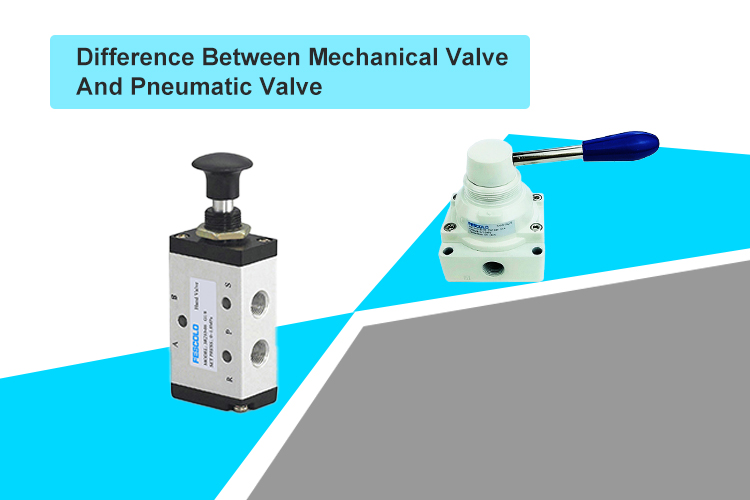
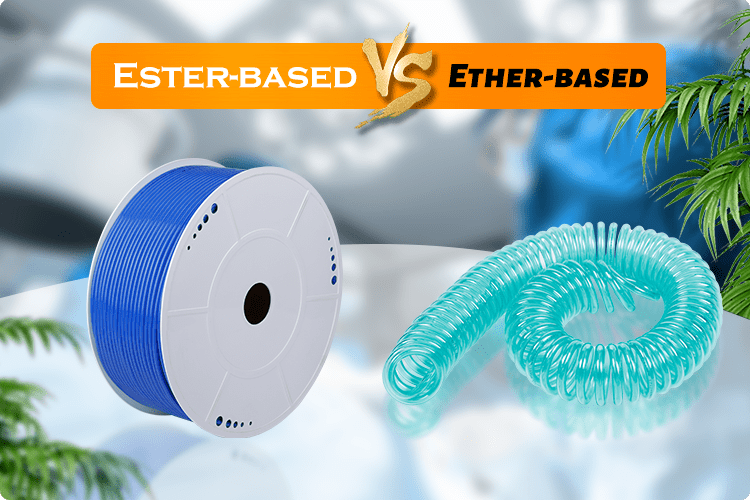
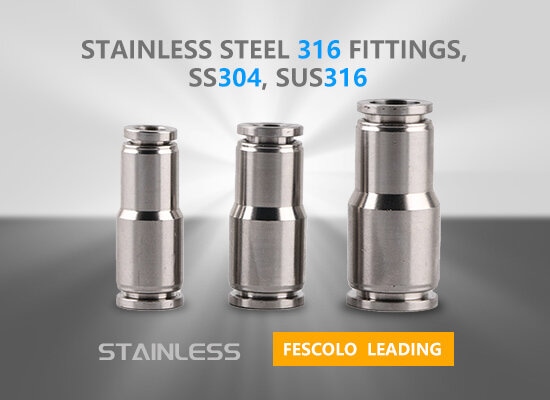
May 16, 2019 Blog
STAINLESS STEEL 316 FITTINGS, SS304, SUS316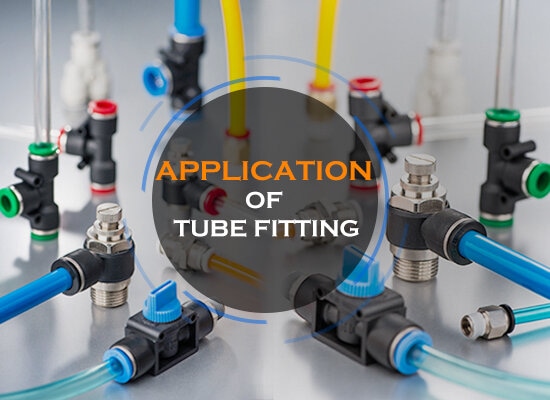
May 03, 2018 Blog
Application Of Tube Fitting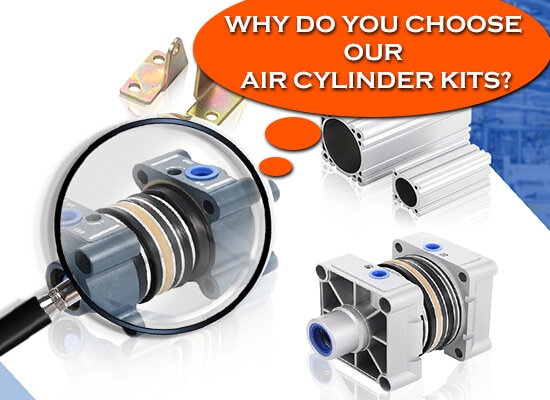
Jun 08, 2018 Blog
Why Do You Choose Our Air Cylinder kits?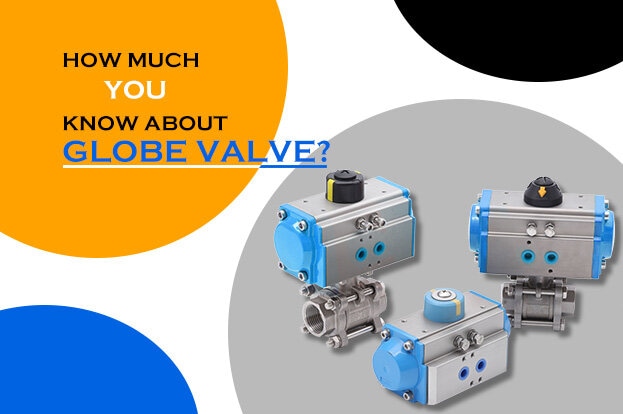
Feb 09, 2018 Blog
How much you know about globe valve?FOKCA ©1998-2025 Fescolo Pneumatic All Rights Reserved Sitemap